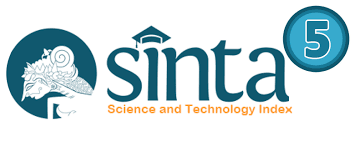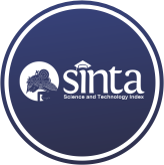Analisa Kepuasan Pengunjung di Objek Wisata Pemandian Kaliwetan Menggunakan Algoritma Naïve Bayes
(1) STIKOM Tunas Bangsa, Pematangsiantar, Indonesia
(2) STIKOM Tunas Bangsa, Pematangsiantar, Indonesia
(*) Corresponding Author
Abstract
Full Text:
PDFReferences
D. N. Batubara and A. P. Windarto, “Analisa Klasifikasi Data Mining Pada Tingkat Kepuasan Pengunjung Taman Hewan Pematang Siantar Dengan Algoritma,” KOMIK (Konferensi Nas. Teknol. Inf. dan Komputer), vol. 3, no. 1, pp. 588–592, 2019, doi: 10.30865/komik.v3i1.1664.
M. Isa, “Pengaruh Kualitas Fasilitas Wisata Terhadap Kepuasan Pengunjung Pemandian Air Panas ‘Aek Milas Siabu’ Kabupaten Mandailing Natal,” Jesya (Jurnal Ekon. Ekon. Syariah), vol. 3, no. 2, pp. 111–125, 2020, doi: 10.36778/jesya.v3i2.184.
D. Amanah and K. Budiarta, “Kepuasan Pengunjung Tempat Wisata Pemandian Hairos Waterpark Medan,” PLANS, vol. 13, no. 1, pp. 44–50, 2018.
D. Anggraini, S. Solikhun, F. Rizki, and P. P. P. A. N. W. Fi. I. R. . Zer, “Implementasi Data Mining Untuk Menganalisa Tingkat Kepuasan Konsumen Terhadap Kualitas Pelayanan Toko Online Second Gangbrand Menggunakan Metode Algoritma C4.5,” J-MENDIKKOM, vol. 1, no. 2, 2024.
A. Natuzzuhriyyah and N. Nafisah, “Klasifikasi Tingkat Kepuasan Mahasiswa Terhadap Pembelajaran Secara Daring Menggunakan Algoritma Naïve Bayes,” Techno Xplore J. Ilmu Komput. dan Teknol. Inf., vol. 6, no. 2, pp. 61–67, 2021, doi: 10.36805/technoxplore.v6i2.1377.
A. R. Damanik, S. Sumijan, and G. W. Nurcahyo, “Prediksi Tingkat Kepuasan dalam Pembelajaran Daring Menggunakan Algoritma Naïve Bayes,” J. Sistim Inf. dan Teknol., vol. 3, pp. 88–94, 2021, doi: 10.37034/jsisfotek.v3i3.49.
P. A. M. Z. R.W.P.P.Zer and I. Gunawan, “Penerapan Data Mining Naïve Bayes Dalam Klasifikasi Kepuasan Mahasiswa Berlangganan WiFi Indihome,” J. Media Inform., vol. 3, no. 2, pp. 112–118, 2022, doi: 10.55338/jumin.v3i2.488.
H. Chen, S. Hu, R. Hua, and X. Zhao, “Improved Naive Bayes Classification Algorithm for Traffic Risk Management,” EURASIP J. Adv. Signal Process., vol. 2021, no. 1, 2021, doi: 10.1186/s13634-021-00742-6.
T. H. Apandi and C. A. Sugianto, “Algoritma Naive Bayes untuk Prediksi Kepuasan Pelayanan Perekaman e-KTP,” JUITA, vol. 7, no. 2, 2019.
F. R. D. Febriantoro, H. Tazkia, and R. Ghaniy, “Penerapan Metode Naïve Bayes dalam Sistem Informasi Penentuan Kelayakan Peserta Pekan Ilmiah Mahasiswa,” Digitech, vol. 4, no. 1, pp. 169–179, 2024.
M. N. Zarti, E. Sahputra, A. Sonita, and Y. Apridiansyah, “Application Of Data Mining Using The Naïve Bayes Classification Method To Predict Public Interest Participation In The 2024 Elections,” J. Komputer, Inf. dan Teknol., vol. 3, no. 1, pp. 105–114, 2023, doi: 10.53697/jkomitek.v3i1.1192.
M. Makhtar, H. Nawang, and S. N. W. Shamsuddin, “Analysis On Students Performance Using Naive Bayes Classifier,” J. Theor. Appl. Inf. Technol., vol. 95, no. 16, pp. 3993–4000, 2017, [Online]. Available: www.jatit.org
O. P. Barus, R. Romindo, and J. J. Pangaribuan, “Classification of Hearing Loss Degrees with Naive Bayes Algorithm,” Resti, vol. 2, no. 2, 2022.
N. F. Rusland, N. Wahid, S. Kasim, and H. Hafit, “Analysis of Naïve Bayes Algorithm for Email Spam Filtering across Multiple Datasets,” IOP Conf. Ser. Mater. Sci. Eng., vol. 226, no. 1, 2017, doi: 10.1088/1757-899X/226/1/012091.
M. Anggraini, R. A. Tyas, I. A. Sulasiyah, and Q. Aini, “Implementasi Algoritma Naïve Bayes Dalam Penentuan Rating Buku,” Sistemasi, vol. 9, no. 3, p. 557, 2020, doi: 10.32520/stmsi.v9i3.915.
J. Jefriyanto, N. Ainun, and M. A. Al Ardha, “Application of Naïve Bayes Classification to Analyze Performance Using Stopwords,” JISTE (Journal Inf. Syst. Technol. Eng., vol. 1, no. 2, pp. 49–53, 2023, [Online]. Available: https://www.ncbi.nlm.nih.gov/books/NBK558907/
DOI: https://doi.org/10.30645/brahmana.v5i2.464
DOI (PDF): https://doi.org/10.30645/brahmana.v5i2.464.g459
Refbacks
- There are currently no refbacks.
Published Papers Indexed/Abstracted By:















